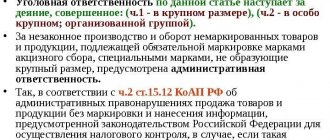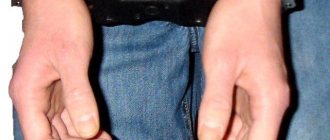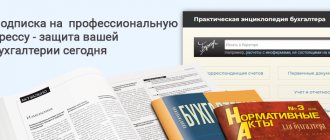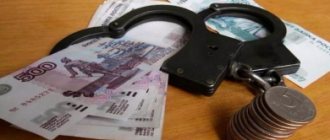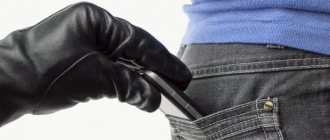When purchasing any product, each of us has the right to count on possessing a product of original quality. But often, instead of a safe and reliable item, we end up with counterfeit products. Most of us are familiar with the feeling of annoyance and disappointment that you experience when you realize that the purchased product (often very expensive) turns out to be simply a counterfeit of a well-known brand. How to behave when faced with such a situation, and are there ways to recognize counterfeit?
Counterfeit products are dangerous because they use low-quality, toxic materials for their manufacture, which can adversely affect human health.
Counterfeit products: what is it and why is it dangerous?
There have always been many people who wanted to capitalize on the good name of bona fide manufacturers of their original products. The young Russian market economy encountered the concept of counterfeit in the 90s. A mass of counterfeits of almost all types of goods poured onto the shelves. Remember the famous “Abibas”, a copy of the famous sportswear brand.
Economic pirates especially loved popular Western brands: brands of perfume, bags and electronics. Inexperienced buyers found themselves in possession of “real” items from the luminaries of the fashion industry. They were literally purchased at market stalls and had very reasonable prices. Only at home, having looked closely at the name on the “label,” did citizens begin to understand that they had not bought “Wrangler” and “Salamander,” but something completely different. And the quality, upon closer examination, turned out to be not “branded”.
Of course, the culture of counterfeiting has grown since then. It is not always possible to recognize a scam even during operation. But a fake, even one of acceptable quality, remains a fake.
Counterfeiting is the production and launch on the market of counterfeits of well-known brands with minor changes (and sometimes even without them) in the appearance of the product for the purpose of making a quick profit.
In other words, this is speculation on the quality of goods of famous brands, which are someone else’s intellectual property, and someone else’s copyrights.
The range of such goods has rapidly expanded, and now covers almost all areas of consumer consumption available to fraudulent manufacturers. In addition to light industrial items, they influenced the production of counterfeits of household chemicals, cosmetics and perfumes, medicines, food products (especially canned meat and fish), children's goods, household appliances, and others.
Copyright holders are suffering multimillion-dollar losses, and foreign investors are rapidly losing interest in the Russian market. In addition, pirates use low-quality materials, and often toxic (poisonous) plastic and other harmful materials.
Counterfeit products have neither certificates nor licenses, which means you cannot be sure of their quality.
Imitation products
They are called goods produced with stylistic borrowing or copying of some elements of the trademark of a well-known manufacturer. Simply put, a certain company produces a product that is very similar in appearance and name to a popular brand in order to mislead consumers. For example, in stores you can find Taft and Taff hairsprays, cosmetic products from the Nivea and Livea brands. Outwardly they look almost the same.
Many businesses seek to use the popularity of well-known companies to increase their own sales. The release of counterfeit products can be carried out not only by companies unknown to the copyright holder, but also by their business partners. The pursuit of big profits often leads to litigation. Former partners begin to dispute ownership of a famous brand. As a rule, as a result of a dispute, the imitation trademark is liquidated.
Types of counterfeit products
- The easiest thing for counterfeiters to do is to release products that look very slightly different from authentic samples.
This consists of changing the logo (rearranging or replacing one letter in the name). The remaining supporting points - corporate color, font, size and shape of the product - remain completely identical to the original and deceive the inattentive buyer. It is not difficult to recognize such counterfeit products, but bringing the perpetrators to justice is not always possible due to the fact that they use a “similar, but different” trademark.
- Often, counterfeiters do not even bother replacing any parts, but copy a branded sample, so it is impossible to distinguish a fake when purchasing.
This risk is justified by the fact that the buyer, without a doubt, has confidence in the product. It costs more than the first option, which means it brings significantly more profit. True, it is much easier to hold such enterprising producers and distributors accountable if they are caught red-handed - all the indicators of a crime are there. This means that the chance of initiating a criminal case increases significantly.
- Duplicating and selling copies of musical, film and artistic works, fiction and popular literature without the knowledge and consent of the authors and performers is piracy, one of the most ruinous types of counterfeit for copyright holders.
Small record companies and little-known labels are suffering huge losses because free access to music and films on the Internet completely deprives them of income.
- Assignment of copyright for technical solutions and discoveries. Use without the consent of the inventor, developer of his patent rights.
Grayvoronsky urban district
When purchasing any product, each of us has the right to count on possessing a product of original quality. But often, instead of a safe and reliable item, we end up with counterfeit products. Most of us are familiar with the feeling of annoyance and disappointment that you experience when you realize that the purchased product (often very expensive) turns out to be simply a counterfeit of a well-known brand. How to behave when faced with such a situation, and are there ways to recognize counterfeit?
Counterfeit products are dangerous because they use low-quality, toxic materials for their manufacture, which can adversely affect human health.
Counterfeit products: what is it and why is it dangerous?
There have always been many people who wanted to capitalize on the good name of bona fide manufacturers of their original products. The young Russian market economy encountered the concept of counterfeit in the 90s. A mass of counterfeits of almost all types of goods poured onto the shelves. Of course, the culture of counterfeiting has grown since then. It is not always possible to recognize a scam even during operation. But a fake, even one of acceptable quality, remains a fake.
Counterfeiting is the production and launch on the market of counterfeits of well-known brands with minor changes (and sometimes even without them) in the appearance of the product for the purpose of making a quick profit.
In other words, this is speculation on the quality of goods of famous brands, which are someone else’s intellectual property, and someone else’s copyrights.
The range of such goods has rapidly expanded, and now covers almost all areas of consumer consumption available to fraudulent manufacturers. In addition to light industrial items, they influenced the production of counterfeits of household chemicals, cosmetics and perfumes, medicines, food products (especially canned meat and fish), children's goods, household appliances, and others.
Copyright holders are suffering multimillion-dollar losses, and foreign investors are rapidly losing interest in the Russian market. In addition, pirates use low-quality materials, and often toxic (poisonous) plastic and other harmful materials.
Counterfeit products have neither certificates nor licenses, which means you cannot be sure of their quality.
Types of counterfeit products
- The easiest thing for counterfeiters to do is to release products that look very slightly different from authentic samples.
This consists of changing the logo (rearranging or replacing one letter in the name). The remaining supporting points - corporate color, font, size and shape of the product - remain completely identical to the original and deceive the inattentive buyer. It is not difficult to recognize such counterfeit products, but bringing the perpetrators to justice is not always possible due to the fact that they use a “similar, but different” trademark.
- Often, counterfeiters do not even bother replacing any parts, but copy a branded sample, so it is impossible to distinguish a fake when purchasing.
This risk is justified by the fact that the buyer, without a doubt, has confidence in the product. It costs more than the first option, which means it brings significantly more profit. True, it is much easier to hold such enterprising producers and distributors accountable if they are caught red-handed - all the indicators of a crime are there. This means that the chance of initiating a criminal case increases significantly.
- Duplicating and selling copies of musical, film and artistic works, fiction and popular literature without the knowledge and consent of the authors and performers is piracy, one of the most ruinous types of counterfeit for copyright holders.
Small record companies and little-known labels are suffering huge losses because free access to music and films on the Internet completely deprives them of income.
- Assignment of copyright for technical solutions and discoveries. Use without the consent of the inventor, developer of his patent rights.
What is the difference between counterfeits and fakes?
Concepts such as counterfeit and counterfeit are often used when talking about the same thing - counterfeit. Meanwhile, they are not identical. Let's take a closer look:
- Counterfeit in its essence is a product that is created on the basis of an existing “high-profile” brand, using its features.
That is, these are products, often of high quality (a fake can also be of high quality), but not produced by the copyright holder, without his knowledge and consent.
- Counterfeit is a low-quality counterfeit product that an illegal manufacturer passes off as genuine. Counterfeits pose a real danger to consumers, as they can harm life and health.
The composition of the product written on the packaging, as a rule, has nothing to do with the real contents. Deception in indicating the truthful characteristics of the product, deliberately misleading the buyer is characteristic of counterfeiters.
Counterfeit as a type of counterfeit can also have features of counterfeit. But when the quality characteristics of the product and its composition change (in order to reduce the cost), it ceases to have the properties of the original sample. The difference between counterfeit and counterfeit is the fundamental difference in the constituent components of the counterfeit product.
The most dangerous counterfeit options
The category of the most dangerous counterfeiters, for which the court may increase the penalty, are:
- Medicines are dummies;
- “Scorched” alcohol and tobacco products;
- Food products produced in violation of sanitary and technical standards;
- Children's toys and child care items with toxic ingredients.
To avoid purchasing counterfeit products, always ask to see the product license from the seller.
How to recognize counterfeit products
Of course, there are very few general rules for recognizing a fake. It is advisable to look carefully at the product you are purchasing. Sometimes they give out a fake:
- Incorrect spelling of the logo,
- blurry letters
- Lack of protection signs,
- Inconsistencies in composition
- Suspicious “chemical” smell.
But each type of product bears certain features that indicate authenticity.
Counterfeit alcohol
Toxic contents cannot be recognized upon purchase. However, one should be wary of the presence of sediment, the absence of a tax stamp, and an untidy label. A good sign is the presence of “branded” corrugated signs and inscriptions on the bottle, the presence of excise or federal stamps.
It is advisable to purchase alcohol only in large retail outlets (preferably, specialized in the sale of alcoholic beverages), avoiding purchases “from hand” or from stalls at bus stops. The risk of purchasing a craft that is dangerous to life and health is much lower there.
Counterfeit medicines
The advice is the same - look carefully at the packaging. Read and compare the name on the box with the original one, pay attention to the security symbols, the clarity and clarity of the written instructions, and the integrity of the box.
It is necessary to purchase medicines, like alcohol, only in large chain pharmacies, in no case by hand, on the Internet, or at dubious points. Your life depends on it.
For more information on protection against counterfeit products, you can consult a lawyer on our website. We work around the clock and for free.
What does counterfeit threaten to do to the buyer?
It is difficult for a person who is ignorant of the subtleties and differences between a fake and an original to protect himself and loved ones from possible troubles associated with consuming a low-quality product.
But knowing that he is purchasing a counterfeit product, the buyer not only ensures the prosperity of the illegal business. He takes responsibility for his own safety.
Responsibility of the seller of counterfeit goods
The law protects the interests of legitimate intellectual property owners. This means that if cases of trade in counterfeit goods are detected, the seller is liable, even if he himself was not aware of this and considered the products to be of good quality.
Prosecution for the production and trade of counterfeit goods can be held as part of an administrative penalty. The production of different types of goods is punished differently. This is most often expressed in the form of a fine, the amount of which is determined by the court.
Compensation for damages depends on the status of the offender and the intended circulation of counterfeit products. Typically, compensation is paid in the range from 10,000 to 5 million rubles.
In some cases provided for by law, offenders are subject to more severe punishment. Sometimes the activities of counterfeiters end with their criminal prosecution. This happens in cases where the activities of offenders pose a threat to the life and health of citizens, and also cause major damage to the interests of the state.
! Upon a court verdict, counterfeit products are necessarily withdrawn from circulation and destroyed at the expense of the seller.
A legal entity that violates the rights of the legal owner of intellectual property is liquidated. The IP is terminated.
What is the difference between counterfeits and fakes?
Concepts such as counterfeit and counterfeit are often used when talking about the same thing - counterfeit. Meanwhile, they are not identical. Let's take a closer look:
- Counterfeit in its essence is a product that is created on the basis of an existing “high-profile” brand, using its features.
That is, these are products, often of high quality (a fake can also be of high quality), but not produced by the copyright holder, without his knowledge and consent.
- Counterfeit is a low-quality counterfeit product that an illegal manufacturer passes off as genuine. Counterfeits pose a real danger to consumers, as they can harm life and health.
The composition of the product written on the packaging, as a rule, has nothing to do with the real contents. Deception in indicating the truthful characteristics of the product, deliberately misleading the buyer is characteristic of counterfeiters.
Counterfeit as a type of counterfeit can also have features of counterfeit. But when the quality characteristics of the product and its composition change (in order to reduce the cost), it ceases to have the properties of the original sample. The difference between counterfeit and counterfeit is the fundamental difference in the constituent components of the counterfeit product.
Features of terminology
The main factor behind large-scale counterfeiting of products is the presence of the shadow sector in the economy. In terms of the volume of its production, it can well be considered a parallel economy.
In the media, some legal publications and a number of regulatory documents, the terms “counterfeit” and “falsified” product are often used interchangeably. Meanwhile, from a legal point of view, these are independent concepts.
The word "counterfeiting" has Latin roots. Literally it translates as “fake”. Counterfeiting is the illegal use of brand names to make a profit in the production and sale of products similar to those of well-known manufacturers.
Counterfeiting refers to actions aimed at deceiving consumers by falsifying the object of a purchase and sale transaction. In a broad sense, it can be considered as illegal actions, the purpose of which is to deteriorate certain properties of the product, reduce its quantity while maintaining the same characteristic indicators that are not significant for the buyer.
Counterfeiting is, in essence, a violation of copyright, and falsification is a violation of production technology. Accordingly, a counterfeit product is always counterfeit, and counterfeit products are not always counterfeit.
The most dangerous counterfeit options
The category of the most dangerous counterfeiters, for which the court may increase the penalty, are:
- Medicines are dummies;
- “Scorched” alcohol and tobacco products;
- Food products produced in violation of sanitary and technical standards;
- Children's toys and child care items with toxic ingredients.
To avoid purchasing counterfeit products, always ask to see the product license from the seller.
Have a question for a lawyer? Ask now, call and get a free consultation from leading lawyers in your city. We will answer your questions quickly and try to help with your specific case.
Telephone in Moscow and the Moscow region: +7
Phone in St. Petersburg and Leningrad region: +7
Free hotline throughout Russia: 8 (800) 301-39-20
Why is counterfeit so popular?
We have to admit that counterfeit goods continue to conquer the market.
Almost all positions of consumer interest are covered by “gray” manufacturers. Clothing, medicines, alcoholic beverages, canned food and other food products, children's products, cosmetics and perfumes, and household appliances are counterfeited.
The blame for this partly lies with law enforcement agencies, who have little interest in combating violators of intellectual and copyright rights. This is usually caused by a banal high interest of a financial nature.
After all, manufacturers and sellers of counterfeit goods are not particularly hiding from the law. And counterfeits that enter the Russian market thanks to the goodwill of customs officers would generally be easiest to stop “at the entrance” to the country.
As for the high demand for counterfeit products, this is also understandable, especially in times of crisis. Of course, price plays a decisive role. It is much more attractive than that of an authentic product.
The low price is explained by the fact that manufacturers of counterfeits do not incur any additional costs - they do not have to invent, patent, or “promote” the product on the market with advertising, quality improvements and unusual characteristics and properties. The technical capabilities are very great - just take it and copy it. Low cost, but very profitable. And against the backdrop of low incomes of citizens and with the tacit consent of law enforcement agencies, counterfeit producers feel confident and in demand.
Normative base
The concept of counterfeit goods was first enshrined in Law No. 3520-1 of 1992. Article 4 of this regulation defined objects that are considered counterfeit. The norm, in particular, states that products, their labels and packaging on which a trademark or a designation confusingly similar to it is illegally placed are counterfeit.
Law No. 5351-1 of 1993 includes phonograms and copies of works whose creation or distribution infringes copyright into the category of counterfeit products.
Counterfeit alcohol
Toxic contents cannot be recognized upon purchase. However, one should be wary of the presence of sediment, the absence of a tax stamp, and an untidy label. A good sign is the presence of “branded” corrugated signs and inscriptions on the bottle, the presence of excise or federal stamps.
It is advisable to purchase alcohol only in large retail outlets (preferably, specialized in the sale of alcoholic beverages), avoiding purchases “from hand” or from stalls at bus stops. The risk of purchasing a craft that is dangerous to life and health is much lower there.
Counterfeit medicines
The advice is the same - look carefully at the packaging. Read and compare the name on the box with the original one, pay attention to the security symbols, the clarity and clarity of the written instructions, and the integrity of the box.
It is necessary to purchase medicines, like alcohol, only in large chain pharmacies, in no case by hand, on the Internet, or at dubious points. Your life depends on it.
For more information on protection against counterfeit products, you can consult a lawyer on our website. We work around the clock and for free.
Responsibility of the seller of counterfeit goods
The law protects the interests of legitimate intellectual property owners. This means that if cases of trade in counterfeit goods are detected, the seller is liable, even if he himself was not aware of this and considered the products to be of good quality.
Prosecution for the production and trade of counterfeit goods can be held as part of an administrative penalty. The production of different types of goods is punished differently. This is most often expressed in the form of a fine, the amount of which is determined by the court.
Compensation for damages depends on the status of the offender and the intended circulation of counterfeit products. Typically, compensation is paid in the range from 10,000 to 5 million rubles.
In some cases provided for by law, offenders are subject to more severe punishment. Sometimes the activities of counterfeiters end with their criminal prosecution. This happens in cases where the activities of offenders pose a threat to the life and health of citizens, and also cause major damage to the interests of the state.
! Upon a court verdict, counterfeit products are necessarily withdrawn from circulation and destroyed at the expense of the seller.
A legal entity that violates the rights of the legal owner of intellectual property is liquidated. The IP is terminated.
Characteristics of methods
The first are based on the abilities of the human senses (hearing, smell, etc.). Organoleptic methods for identifying counterfeits are simple, but not always objective. As a rule, they are used in trade.
The registration method involves observing and counting the number of objects, phenomena, and costs.
Quality indicators are determined by calculation.
The measurement method is considered the most objective. When using it, you can get fairly accurate results. Determination of indicators is carried out using special measuring tools. To use this method, highly qualified specialists and large financial investments are required. Measurements also take quite a lot of time. However, today express analysis and non-destructive testing methods are becoming increasingly popular.
Expert techniques for identifying counterfeits are based on the conclusions of a group of specialists.
How to protect your business from counterfeit products?
Not every retailer has the skills to recognize counterfeit products. It happens that the seller himself is a victim of unscrupulous suppliers of supposedly “branded” products.
In order not to bear responsibility and not to be a victim of your own ignorance, you must adhere to the following rules:
- Be sure to conclude an agreement with the supplier and the manufacturer of the product. It must indicate the manufacturer's rights to the trademark.
- It is mandatory to have a certified copy of the certificate for all supplied products. Certified with a blue seal and signature of the supplier or manufacturer.
- Availability of officially and correctly executed documents for the goods. These are invoices and invoices.
Any entrepreneur must have all these documents a priori; there is nothing special in such requirements. They are the ones who will protect your commercial enterprise from possible troubles.
Please note that Russian legislation is constantly changing and the information we write may become outdated. In order to resolve the issue you have regarding Criminal Law, we advise you to seek the advice of a lawyer in support of the site. To do this, use the form below or contact the specialist directly on the right side of the screen.
